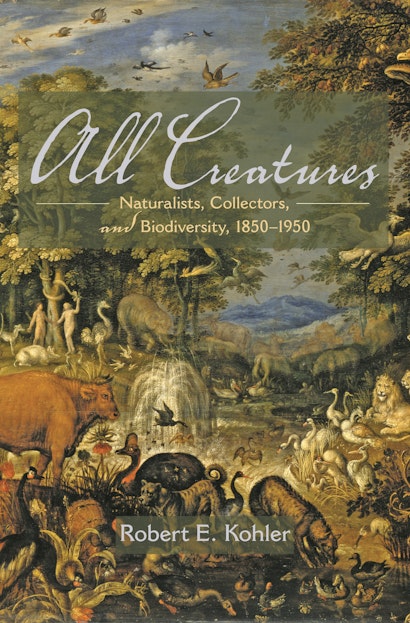We humans share Earth with 1.4 million known species and millions more species that are still unrecorded. Yet we know surprisingly little about the practical work that produced the vast inventory we have to date of our fellow creatures. How were these multitudinous creatures collected, recorded, and named? When, and by whom?
Here a distinguished historian of science tells the story of the modern discovery of biodiversity. Robert Kohler argues that the work begun by Linnaeus culminated around 1900, when collecting and inventory were organized on a grand scale in natural history surveys. Supported by governments, museums, and universities, biologists launched hundreds of collecting expeditions to every corner of the world. Kohler conveys to readers the experience and feel of expeditionary travel: the customs and rhythms of collectors’ daily work, and its special pleasures and pains.
A novel twist in this story is that survey collecting was rooted not just in science but also in new customs of outdoor recreation, such as hiking, camping, and sport hunting. These popular pursuits engendered a wide scientific interest in animals and plants and inspired wealthy nature-goers to pay for expeditions. The modern discovery of biodiversity became a reality when scientists’ desire to know intersected with the culture of outdoor vacationing. General readers as well as scholars will find this book fascinating.
"[A] fascinating and groundbreaking book."—Tim Dee, Times Literary Supplement
"In this new, well-argued book, Kohler plays down the importance of laboratory life to naturalists. Instead he puts their scientific achievements into the contexts of the environment they worked in, the social culture of nature-going they often came from, and, lastly, the science of classification in the tradition of the Swedish naturalist Carl von Linné. . . . An important contribution to the history of naturalists in the United States, it is well worth the read."—Peder Anker, Science
"Fascinating reading. . . . All Creatures presents an excellent summary of the work and lives of explorers and surveyors. Kohler summarizes the rapidly vanishing field of biological surveys for a broad audience, formidably bringing back old times to explain the birth and growth of surveys, collecting and natural history."—Swen C. Renner, EMBO Reports
"In this rich story of discoveries, readers learn of the remarkable natural history work that has identified and named 1.4 million species on Earth. . . . This book portrays the travel, pleasures, and pain of fieldwork in this great century of taxonomy."—Choice
"[This book] opens new perspectives on histories of natural history that did not end with the experimentation of the life sciences in the second half of the nineteenth century. It also challenges the reader to rethink the relationship between social history and a culturally informed history of science."—Tobias Cheung, Canadian Journal of History
"[Kohler's] treatment is a great general read but at the same time, fills an empty niche in the history of American biological sciences. This volume is highly recommended for students of the history of science at any level."—Larry T. Spencer, Quarterly Review of Biology
"Kohler thoughtfully examines the whole issue of surveys versus discoveries and collectors versus explorers. . . . While scientific and environmental circumstances have changed, Kohler has succeeded in restoring these naturalists to their rightful place in the history of natural history."—Mark Madison, International History Review
"Despite the spatio-temporal restriction of Kohler's subject, he manages to place it into a context of more general interest and importance by elaborating the environmental, cultural, and scientific backgrounds of survey collecting. Any systematist curious about the processes that have been responsible for filling the filing cabinets of American natural history museums should read this book."—Ronald A. Jenner, The Systematist
"Kohler's book will be useful for science educators who wish to broaden their discussions of diversity with an historical dimension. It will be especially useful for those in the United States who can use the book to point to work done in local regions that had significant national and international scientific importance. And, in that sense, the study provides a useful and highly readable source that brings together a lot of recent historical research."—Paul Lawrence Farber, Science Education
"This is a good book and a good challenge for today."—João Gomes, International Journal of Environmental Studies
"Robert Kohler again provides observations that are creative and thought-provoking as he turns his attention to naturalists and their field work, especially in the''inner frontiers' of North America. His topical approach grounds his arguments in a rich array of primary sources, and he also tracks in a sure-footed way through the extensive secondary literature that surrounds his study of naturalists, the changing landscape of the early twentieth century, and the rather dramatic changes occurring in the emerging biological studies that have been the focus of most historical attention."—Sally Gregory Kohlstedt, University of Minnesota
"This book represents new ground cleared by a major scholar. Robert Kohler calls attention to a group of survey biologists working in the late nineteenth century and the early twentieth century, and explains the context that made possible their scientific work and hence their scientific ideas."—Philip J. Pauly, Rutgers University

